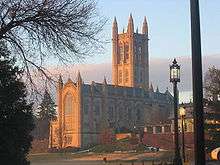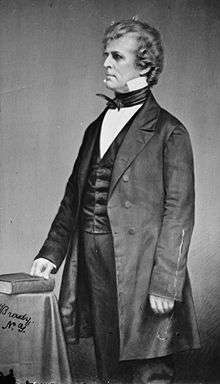Trinity College (Connecticut)
 | |
Former names | Washington College (1823–1845) |
|---|---|
| Motto | Pro Ecclesia Et Patria (Latin) |
Motto in English | For Church and Country |
| Type | Private |
| Established | May 1823 |
| Endowment | US$577.0 million[1] (2017) |
| President | Joanne Berger-Sweeney |
| Dean | Tim Cresswell |
Academic staff | 267 |
| Students | 2,350 |
| Undergraduates | 2,259 (Fall 2016)[2] |
| Postgraduates | 91 (Fall 2016)[2] |
| Location | Hartford, Connecticut, U.S. |
| Campus | Urban |
| Colors | Blue and old gold |
| Athletics | NCAA Division III – NESCAC |
| Nickname | Bantams |
| Affiliations | CIC, Annapolis Group, Oberlin Group, CLAC |
| Sports | 29 varsity teams[3] |
| Mascot | Bantam |
| Website |
www |
 | |
Trinity College is a private liberal arts college in Hartford, Connecticut. Founded in 1823, as an Episcopal Church alternative to Yale. It is the second-oldest college in the state of Connecticut. The college has an urban campus.
Coeducational since 1969, the college enrolls 2,300 students. Trinity offers 38 majors and 26 minors, with a student to faculty ratio of 9:1. 73.1 percent of classes at the college contain less than 20 students.[4] The college is a member of the New England Small College Athletic Conference (NESCAC), informally referred to as the Little Ivies. U.S. News & World Report has ranked Trinity tied for 46th in its 2019 ranking of best national liberal arts colleges in the United States.[5]
History
Early history
.jpg)
Early Connecticut was dominated by Congregationalists. Episcopalians, who had long sought to set up their own college, were provided an opportunity when the Connecticut Constitution disestablished the Congregationalist Church in 1818. It was taken by Bishop Thomas Brownell, who opened Washington College in 1824 to nine students[6] and the vigorous protest of Yale alumni.
A fourteen-acre site was chosen, at the time about a half-mile from the city of Hartford. Over time Bushnell Park was laid out to the north and the east, creating a beautiful space.[7]
The college was renamed Trinity College in 1845; the original campus consisted of two Greek Revival buildings, one housing a chapel, library, and lecture rooms and the other, a dormitory.[8]
The site next to Bushnell Park, where Trinity College then stood, was deemed to be an ideal location to build a state house.[7] So the trustees were persuaded to sell the entire campus to the city in 1872 for $600,000.[7] The trustees moved the college to an 80-acre site on a ridge on the western edge of Hartford.[7] Then-president Abner Jackson hired an English architect to draw up plans for an entire campus.[7] Construction of the new campus was begun under the presidency of Thomas Ruggles Pynchon (1874–1883).[7]
New campus
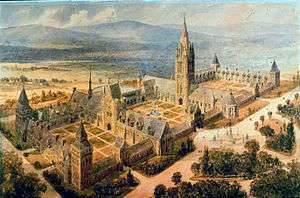
In 1872, Trinity College was persuaded by the state to move from its downtown "College Hill" location (now Capitol Hill, site of the state capitol building) to its current 100-acre (40 ha) campus a mile southwest. Although the college sold its land overlooking the Park River and Bushnell Park in 1872, it did not complete its move to its Gallows Hill campus until 1878.[9] The original plans for the Gallows Hill site were drawn by the noted Victorian architect William Burges but were too ambitious and too expensive to be fully realized. Only one section of the proposed campus plan, the Long Walk, was completed.
By 1889 the library contained 30,000 volumes, and the school boasted over 900 graduates.[7] Enrollment reached 122 in 1892. President Remsen Ogilby (1920–43) enlarged the campus, and more than doubled the endowment. The faculty grew from 25 to 62, and the student body from 167 to 530 men. Under President Keith Funston (1943–51), returning veterans expanded the enrollment to 900.[6]
Twentieth century
Trinity ended the nineteenth century as an institution primarily serving the Hartford area. The early years of the century were primarily growth years for Trinity. Enrollment was increased to 500 men.
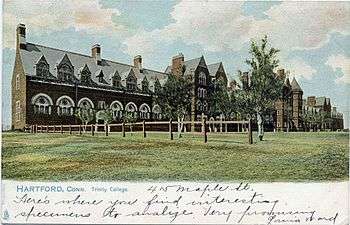
In 1932, under President Remsen Ogilby, the Gothic chapel was completed and became the symbol of Trinity College. It replaced the Seabury chapel which had become too small for the student body.
The founding of the University of Hartford in 1957 allowed Trinity to focus on becoming a regional institution rather than a local one.
In 1962, Connecticut Public Television (CPTV) began its first broadcasts in the Trinity College Public Library, and later in Boardman Hall, a science building on campus.[10][11]
In 1968 the trustees voted to withdraw from the Association of Episcopal Colleges.
Also in 1968, the trustees of Trinity College voted to make a commitment to enroll more minority students, providing financial aid as needed. This decision was preceded by a siege of the administrative offices in the Downes and Williams Memorial buildings during which Trinity students would not allow the president or trustees to leave until they agreed to the resolution.
Less than one year later, Trinity College became coeducational and admitted its first female students, as transfers from Vassar College and Smith College. Today, women make up about 50 percent of Trinity's student body.
Academics

Trinity offers three degrees: the B.A., B.S., and M.A. (in a few subjects). The college offers 41 majors, as well as the options of creating a self-designed major or adding an interdisciplinary or departmental minor. Trinity is part of a small group of liberal arts schools that offer degrees in engineering. Trinity has a student to faculty ratio of 9:1.
Study abroad
Study away is a part of the Trinity experience and is also a component of Trinity’s urban/global focus. Approximately 70 percent of Trinity undergraduates study abroad or in another U.S. city before graduating. In addition to the Trinity College, Rome Campus, Trinity has programs in Paris, Barcelona, Vienna, Trinidad and Tobago, Cape Town, and Buenos Aires that are partially staffed by Trinity professors. In addition there are many other study abroad programs which Trinity students are approved to take part in. In 2012 Trinity established a program in Shanghai through a partnership with Fudan University.[12][13]
Trinity College, Rome Campus
Trinity College, Rome Campus (TCRC), is a study abroad campus of Trinity College. It was established in 1970 and is in a residential area of Rome on the Aventine Hill close to the Basilica of Santa Sabina within the precincts of a convent run by an order of nuns.[14]
The program usually consists of 50–70 students from different American colleges and universities. Students can either attend TCRC for a semester or for their summer program. Each semester, there are usually a range of courses from economics to art history. Most courses make use of the city of Rome by conducting numerous walking tours and trips. Every student enrolled in the program is required to take the appropriate level of study of Italian language. The program also regularly makes trips to other parts of Italy, such as Florence, Venice, and Capri.
Admissions

Admission to Trinity has been increasingly competitive in recent years; this may be attributed to a large increase in admission applications. In January 2011, Trinity's Dean of Admissions reported a 45% application increase. A New York Times article in January 2011 noted a 47% increase, the highest increase of the nation's most selective colleges.[15][16][17]
For the class of 2019, Trinity received 7,570 applications and accepted 2,530 (33.4%); 559 enrolled.[18] The yield rate (the percentage of accepted students who enroll) was approximately 22%.[18] The middle 50% range of SAT scores for enrolled freshmen was 570–670 for critical reading, 580–670 for math, and 580–670 for writing.[18]
For the class of 2021, Trinity received 6,085 applications and accepted 33%; 604 enrolled.
Rankings and reputation
| University rankings | |
|---|---|
| National | |
| Forbes[19] | 89 |
| Liberal arts colleges | |
| U.S. News & World Report[20] | 46 |
| Washington Monthly[21] | 85 |
Trinity is noted as one of the Little Ivies, along with universities and colleges such as Bates, Bowdoin, Colby, Amherst, Middlebury, Swarthmore, Wesleyan, and Williams College.[22]
U.S. News & World Report ranked Trinity 46th in its 2019 ranking of best national liberal arts colleges in the United States. It was also ranked 38th for best value schools.[5] Additionally, College Choice ranked Trinity 19th amongst best national liberal arts colleges.[23] However, the college joined the "Annapolis Group" in August 2007, an organization of more than 100 of the nation's liberal arts schools, in refusing to participate in the magazine's rankings.[24]
The Wall Street Journal has ranked Trinity as one of the 50 best "feeder schools" in the nation for top graduate school programs.[25] Data compiled by the National Science Foundation lists Trinity as a liberal arts college that graduates disproportionately high numbers of future scientists.
In 2016, authors Howard and Matthew Greene continued to include Trinity in the third edition of Hidden Ivies: 63 Top Colleges that Rival the Ivy League.[26] In addition, The Princeton Review has given Trinity a 92 (out of 99) for selectivity and in 2017 named Trinity as a best value college. In 2018Forbes magazine ranked Trinity College 89th in the country and 35th for best liberal arts universities. TIME magazine ranked Trinity College 84th among all colleges and universities in the nation.[27][28]
A 2011 Huffington Post article named Trinity one of the top 10 trendiest schools in the United States, along with other exclusive schools such as Columbia and Yale. The article noted Trinity's "drastic application increases and soaring student reviews" and "close-knit student body."[17]
Student life
Traditions
Matriculation
The matriculation ceremony, sometimes referred to as the "signing of the books," first started in 1826 and is the oldest continuously observed tradition at Trinity. First year students formally join Trinity College as students by signing the matriculation register. By signing the register, students agree to the declaration found in The Charter and Standing Rules that reads: "I promise to observe the Statutes of Trinity College; to obey all its Rules and Regulations; to discharge faithfully all scholastic duties imposed upon me; and to maintain and defend all the rights, privileges, and immunities of the College according to my station and degree in the same." Symbolic of Trinity's becoming coeducational in 1969, the first student to sign the matriculation register was a woman.[29]
The Bantam
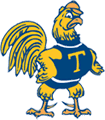
Trinity's mascot, the bantam, was conceived by Joseph Buffington, Class of 1875, who was a federal judge and trustee of the college. He was a noted speaker, and gave an address during an 1899 dinner with alumni of other prestigious colleges. Giving his view on what a Trinity student is, and supporting his view that Trinity students are different from the "collegiate barnyard" consisting of Harvard and Yale (amongst others such as Amherst), Buffington said: "But I tell you, my fellow chanticleers, that the Trinity bantam has been brought up in the Trinity barnyard on different principles, and the most marked outcome of his collegiate training is the fostering of a habit which leads him to size things from his own standpoint, and not have somebody else size them for him." He continued, saying: "You will therefore understand, gentlemen, the spirit in which the Trinity bantam, game from comb to spur, crows at your door, hops in, shakes his tail feathers, and with a sociable nod to the venerable John, and a good natured "How d'ydo" to the ponderous old Elihu steps into the collegiate cock pit, makes his best bow to the tiger, says he is glad to be here, is not a whit abashed at your hugeness, [and] is satisfied with himself and his own particular coop." [29]
Subsequent to this address, word spread throughout campus, and newspapers began to refer to the Trinity athletic teams as the "bantams." Soon after, the bantam became accepted at Trinity and at fellow colleges as the mascot and has been so ever since.
Alma Mater
Trinity's alma mater is "’Neath the Elms." It was written in 1882 by Trinity student Augustus P. Burgwin to the tune of a song that his butler often sang. When "'Neath the Elms" was written, the college had been planting elm trees on the quad, which remain today. Trinity alumni use this as a motto when referencing Trinity; for example, a Trinity alumnus would say to another: "I'll see you 'neath the elms." The alma mater of Trinity College is also the basis for other terms used on campus, such as "Ol' Trin."
Student publications
- The Trinity Tripod
- The Beacon
A Cappella groups
- Accidentals (All-Male)
- Dischords (Co-ed)
- Pipes (Co-ed)
- Quirks (All-Female)
- Trinitones (All-Female)
Improv groups
- The Moveable Joints
Athletics
The Trinity College Department of Athletics currently sponsors a wide range of sports.
Fraternities and sororities
Officially, approximately 18% of the student body are affiliated with a Greek organization.[30] They operate under guidelines and regulations established and enforced by the Trinity College.
In 2012, then-president James F. Jones proposed a social policy for Trinity College which made a commitment, among other things, to require all sororities and fraternities to achieve gender parity within two years (i.e., for each sorority and fraternity to have an equal number of male and female members) or face closure. Trinity College's co-ed mandate for fraternities and sororities was withdrawn by the school's administration in September 2015, having been replaced by a "Campaign for Community" effort to establish more inclusive social traditions on campus.[31]
Trinity currently has the following sororities and fraternities:[32]
- Alpha Chi Omega (Alpha Chi) was founded as the Order of the Elms in October 2016. Received affiliation with the NPC in May 2017.
- Alpha Chi Rho (Crow) was founded at Trinity College in 1895
- Alpha Delta Phi (AD)
- Alpha Epsilon Pi (AEPi) Tau Beta Chapter
- Alpha Kappa Alpha (AKA)
- Cleo of Alpha Chi (Cleo)
- Kappa Kappa Gamma
- Kappa Sigma
- Lambda Alpha Upsilon
- The Ivy Society (formerly Tri-Delta)
- Pi Kappa Alpha (Pike)
- Psi Upsilon (Psi U)
- St. Anthony Hall (The Hall or St.A’s)
- The Stella Society at Trinity College in September 2016
- Zeta Omega Eta: founded at Trinity College in 2003.
Hartford campus
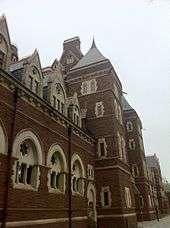
Long Walk Buildings
The first buildings completed on the current campus were Seabury and Jarvis halls in 1878. Together with Northam Towers, these make up what is known as the "Long Walk." These buildings are an early example of Collegiate Gothic architecture in the United States, built to plans drawn up by William Burges, with F.H. Kimball as supervising architect. The Long Walk has been expanded and is connected with several other buildings. On the northernmost end there is the Chapel, whose western side is connected to the Downes and Williams Memorial building. Heading south, the next building is Jarvis Hall, named after Abraham Jarvis. Jarvis becomes Northam Towers heading south, then Seabury Hall. Seabury Hall, named for Samuel Seabury, is connected to Hamlin Hall. To Hamlin's east is Cook, then Goodwin and then Woodard. The dormitories on the Long Walk end there, and the terminal building on the south end of the long walk is Clement/Cinestudio. Clement is the chemistry building; Cinestudio a student run movie theater. If one travels to the south of Hamlin there will be Mather Hall and the Dean of Students Office.[33]
Chapel
The Trinity College Chapel was built in the 1930s to replace Trinity's original chapel in Seabury Hall (now a lecture hall). The Chapel's facade is made almost entirely of limestone and connects to the adjacent Downes Memorial Clock Tower. Its primary architect was Philip Hubert Frohman, of Frohman, Robb and Little, who were also responsible for the National Cathedral in Washington, DC.
Main Quadrangle
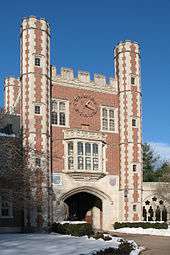
Trinity's campus features a central green known as the Main Quad, designed by famed architect Frederick Law Olmsted. The large expanse of grass is bound on the west by the Long Walk, on the east by the Lower Long Walk, on the north by the Chapel, and on the south by the Cook and Goodwin-Woodward dormitories. While a central green is a feature of many college campuses, Trinity's is notable for its unusually large, rectangular size, running the entire length of the Long Walk and with no walkways traversing it. Trees on the Quad have been planted in a 'T' configuration (for Trinity) with the letter's base at the statue of Bishop Brownell (built 1867).[34] and its top running the length of the Long Walk. Tradition holds that the trees were intended to distinguish Trinity's campus from Yale's. Also on the Quad are two cannons used on the USS Hartford, flagship of Admiral David Farragut during the American Civil War.
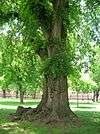
The whole of Trinity's campus is set out on a 100-acre (40 ha) parcel of land that is bound on the south by New Britain Avenue, on the west by Summit Street, on the east by Broad Street, and on the north by Allen Place. Trinity's former northern border, Vernon Street, has been transferred from the city of Hartford to Trinity College and closed off at one end (Broad Street), creating a cul-de-sac within Trinity's borders. Completed in 2001, and on what was formerly an abandoned bus depot adjacent to Trinity's campus, the Learning Corridor is a collection of K-12 public magnet schools co-created by Trinity and the governments of Hartford and Connecticut.
Streets
Crescent Street, on the southeastern end of campus, is the only through street on Trinity's campus. The only other exception until its recent closure was Vernon Street, at the north end of the campus. Since the street was transferred to the school from the city, Trinity widened and repaved it, as well as installing light posts about every ten feet and adding granite crosswalks, curbs, benches, and fenceposts. Vernon Street is the location of most of the campus' cultural houses and Greek organizations, as well as Vernon Social Center. There are also various residences on that street, including the President's house, the Dean of Students' house, other faculty housing, and the Smith House for visitors. There was an additional street added in 2013, after Trinity bought out the public housing occupying Crescent Street. The college built townhouses on this street, giving an off-campus feel to an on-campus housing option. The 8 to 9- person suites are offered to upperclass students and come at an additional cost to normal dormitory-style living. In 2016, the college announced another addition to Crescent street. The Crescent Center for Arts and Neuroscience, which is listed to include an Arts Creativity Corridor, a space for the Neuroscience Program and a Student Common Space.[35]
Other important buildings on campus

- Albert C. Jacobs Life Sciences Center – Built in 1967 in the architectural style of Brutalism, the Life Science Center, or LSC, was designed to be an abstract representation of the Long Walk. The building houses Trinity's departments of Biology and Psychology. It contains several classrooms, an auditorium, teaching labs, research labs, and a greenhouse. Trinity's first dedicated neuroscience lab is to be built in LSC in 2011. Fund raising is underway to construct a neuroscience suite and a music rehearsal hall on the north side of LSC.

- Austin Arts Center – The AAC was designed in the 1960s, and contains art exhibition spaces, two theaters (Garmany and Goodwin), a few classrooms, and is home to the offices of Theater and Dance and Music professors.
- Clement - The Clement Center, is home to the Chemistry department. Clement contains four teaching laboratories, eight research laboratories, instrument rooms, computer rooms, and classrooms. It also offers its own library, conducive to scholarly pursuits and thoughtful concentration. During the summer of 2011, the building will undergo of $750,000 renovation of five of its laboratories through funds provided by the National Science Foundation. Clement is also home to Cinestudio, the on campus movie theater.
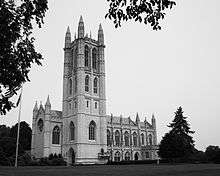
- Chapel The Trinity College Chapel was built in 1933. It was designed by Frohman, Robb and Little, the same architects who designed the National Cathedral in Washington, DC. The chapel is home to various religious services, as well as the service of Nine Lessons and Carols, a long-standing tradition at Trinity. The chapel is the tallest point in the city of Hartford.[36]
- Facilities (formerly Buildings and Grounds) The facilities building is the home of various departments that relate to the maintenance of the physical (as opposed to the academic) aspects of the college. Included in this building is the Director of Facilities, the Superintendent of Grounds, the Superintendent of Construction Trades (who is also the Superintendent of Access Control), various engineers, electricians, painters, carpenters and mechanics.
- Ferris Athletic Center*- Ferris Athletic Center includes a field house, an eight-lane, 37-meter swimming pool with a movable bulkhead, 16 international-size squash courts, two basketball courts, 2 weight rooms (Rick and Anne Hazelton Fitness Center), one of which that is new and used for varsity team athletes, two crew tanks, a wrestling room and a 1/10-mile indoor track. It was named after George M. Ferris, who graduated Trinity. Adjacent to Ferris are 19 acres of playing fields for soccer, lacrosse, field hockey, and baseball as well as the multi- purpose Robin L. Sheppard Field and the 6,500- seat Dan Jessee/Don Miller Football Field and Track.
- Jarvis Hall – This section of the Long Walk contains single, double and quad dorms, primarily for juniors and seniors. It is rumored that the doubles were originally designed for students while the singles across the hallway were intended for their servants. In actuality, the single rooms were single bedrooms, which opened into living areas, which are currently the doubles and the hallway, and six rooms retain this layout. As of the 2008 school year, the massive Long Walk Reconstruction project has been completed, and the dorms are built in a classic style.
- Mather Hall – Just south of Hamlin Hall (the southern terminus of the long walk), Mather Hall is the main student center of Trinity College. The building contains the main dining hall as well as "The Cave" dining hall, a post office and student mail boxes, a coffee house, as well as meeting rooms and large auditoriums.
- Koeppel Community Sports Center – Completed in 2006, the $15.5 million center serves as Trinity's ice hockey arena. The Koeppel Center also serves as a recreational center for students and is open to the public. The Koeppel Center was given a prestigious design recognition as part of the "Facilities of Merit" awards in 2007.[37]
- Roy Nutt Mathematics, Engineering & Computer Science Center – is on the Life Sciences Quad (named for the Life Sciences Center, which dominates the eastern side of the quad) it is made of brick and sandstone. The Nutt Center was designed by renowned architect César Pelli.[38]
- Northam Towers – This central tower on the Long Walk, flanked by the Fuller archway, connects Jarvis and Seabury Halls. The towers contain student housing. The National Fraternity of Alpha Chi Rho was founded in a room within Northam Towers.
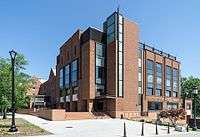
- North Campus Hall - The largest dormitory on Trinity's campus was completed in 1958. The building has since been renovated various times, and spans the trajectory of two streets, from Vernon Street to Allen Place. It is a two-story building with long hallways and multiple common rooms.[39]
- Raether Library and Information Technology Center – Trinity's main library was originally built at the southeast corner of the main quad in the 1950s to replace the library in Williams Memorial. Additional wings were constructed in the 1970s, and a major renovation took place in 2002, at which time the building was given its present name. The Watkinson Library, which houses rare books and manuscripts, occupies an annex of the first floor. The latest renovations, which enlarged the facility to 172,000 square feet (16,000 m2) and more than 1 million volumes, include an atrium, grand reading room, three new computing labs, a multimedia development studio, a music and media center, private study rooms, and a cafe. Though a private academic library, more than 2,800 outside visitors were recorded between November, 2006 and March, 2007.
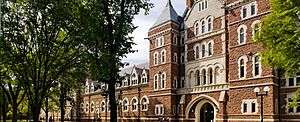
- Seabury Hall – This section of the Long Walk contains classrooms, professor's offices, and four dance studios. Its recent $32.7 million renovation project was completed in 2008. In addition, the old Seabury chapel was renovated into a classroom, maintaining the pews for student seating.
- Trinity Commons * – on the south end of campus on New Britain and Summit St., Trinity Commons is the new arts mecca on campus. It is contains 4 studio classrooms and the newly constructed Performance Lab. The Performance Lab is a massive black box theater that can sit at least 100 people, but can accommodate much more with standing room. It has a set lighting plot with about 100 lights and is the new performance venue for most new student and faculty shows. It also houses many offices on the other side of the building. It is one of the newest buildings on campus and only houses Theater and Dance classes and administrative offices.
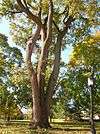
- Vernon Social Center – Vernon Social Center, on Vernon Street, is a multipurpose auditorium used on campus for various events, including concerts and lectures. It is attached to Vernon Place, a dormitory, and makes up the quad housing North Campus Hall and High Rise Hall.
Sustainability Initiatives
Trinity is a signatory of the American College and University Presidents Climate Commitment. Students are involved with programs such as Green Campus, ConnPIRG, and The TREEhouse (Trinity Recreational and Environmental Education House). Students also have access to Zipcars, UPass bus passes.
Trinity College and Hartford
Trinity is in urban Hartford, within walking distance of the state capitol of Connecticut. The main campus is bordered by Summit Street, Allen Place, Broad Street and New Britain Avenue. WRTC-FM serves as the college's radio station, and can be heard throughout Hartford County.
Trinity and the community
Along with Trinity, the Learning Corridor, Hartford Hospital, and The Institute of Living make up the Southside Institutions Neighborhood Alliance, or SINA. SINA aims to create affordable housing in Hartford's Frog Hollow and Barry Square neighborhoods as well as in the creation of the Learning Corridor and the Trinity College Boys and Girls Club.
Trinity's library, computer resources and the new Koeppel Community Sports Complex are available to Hartford residents. The new sports complex functions both as a rink for Trinity’s ice hockey teams and as a public skating rink. Trinity also runs the Trinfo Café which provides Hartford residents with internet and computer access as well as computing services/education.
Trinity has a partnership with the Hartford Magnet Trinity College Academy (formerly Hartford Magnet Middle School) across the street. Trinity advises the school with academic affairs, provide professors to lead summer courses and opens up some Trinity courses to qualified seniors at Hartford Magnet Trinity College Academy.[40]
In the summer months, when not in session, the college opens its campus to the community for its Plumb Memorial Carillon Concerts that are held on Wednesday nights. Trinity's 49-bell Carillon is one of approximately 200 such instruments in North America.
Contributions to the arts
Film
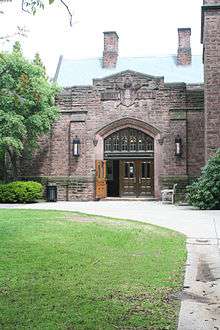
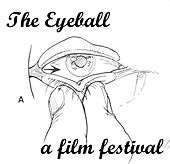
Cinestudio is an art cinema with 1930s-style design. An article in the Hartford Advocate described this non-profit organization, which depends solely on grants and the efforts of volunteer workers who are paid in free movies.[41] Cinestudio has been in the Clement Chemistry Building since it was founded in the 1970s.
Cinestudio is host to the annual Eyeball Film Festival, in which young filmmakers premier their latest works in front of their peers. The festival has judges, each schooled in film from a different perspective, who judge the students' films.
Fine arts
Trinity has a strong faculty in fine arts, including Picasso scholar and art historian Michael C. FitzGerald.
Music
Trinity also hosts the annual Trinity International Hip Hop Festival. A three-day celebration of global hip hop culture, the festival features lectures, panel discussions, workshops and live performances. The festival was founded in 2006 with the goal of unifying Trinity with the city of Hartford.
Since 2006, the station has broadcast the Trinity Samba Fest from the Hartford waterfront featuring regional and international talent.[42] [43] [44]
Notable Alumni
Among Trinity College's distinguished alumni include many influential and historical people, including five governors, US Cabinet members, federal judges, renowned political commentators and journalists, and senior executives in business and industry.

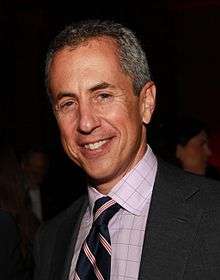
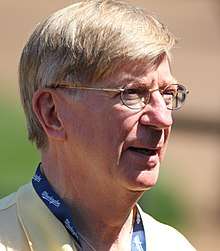

Some notable alumni of Trinity College include:
- Hans W. Becherer, former president and CEO of John Deere
- Tucker Carlson, Fox News conservative commentator, host of Tucker Carlson Tonight, Fox News' number one prime time slot
- Thomas R. DiBenedetto, president of Boston International Group, owner and former chairman of AS Roma
- Ernest de Koven Leffingwell, Arctic explorer
- Danny Meyer, Shake Shack founder and chief executive officer of the Union Square Hospitality Group
- Isaac Toucey, former Secretary of the Navy, Attorney General of the United States and the 18th Governor of Connecticut
- J. H. Hobart Ward, US Army general
- George Will, Pulitzer Prize-winning journalist
- John Williams, eleventh presiding bishop of the Episcopal Church in the United States
- Francis R. Delano, banker, financier, and member of the prominent Delano family
- David Gottesman, American billionaire, founder of the First Manhattan Co., and member of Berkshire Hathaway's board of directors
- Walter Harrison, 5th President of the University of Hartford
- John D. Howard, CEO of Irving Place Capital
- Peter S. Kraus, American businessman, philanthropist, and chairman and CEO of AllianceBernstein and former co-head of the Investment Management Division at Goldman Sachs
- Mitchell M. Merin, former president and chief operating officer of Morgan Stanley Investment Management
- James Murren, chairman of the board and chief executive officer of MGM Mirage
- Charles R. Perrin, chairman of Warnaco, former chairman and CEO of Avon Products and former chairman and CEO of Duracell
- William C. Richardson, board director of Exelon; former president of Johns Hopkins University; former director on the boards of the Kellogg Company, the Bank of New York, CSX Corporation, and Mercantile Bankshares; former head of the Kellogg Foundation
- Thomas R. Savage, former CEO of American International Group
- Percival W. Clement, 57th Governor of Vermont
- Henry McBride, fourth Governor of Washington State
- John S. Phelps, former Governor of Missouri
- Charles C. Van Zandt, 34th Governor of Rhode Island
- Joseph Buffington, Judge, United States Court of Appeals for the Third Circuit
- David Chang, Chef and founder of the Momofuku restaurant group
Notes and references
- ↑ As of June 30, 2017. "Endowment Statistics 2016-17". Trinity College.
- 1 2 "Trinity College Facts 2016-17" (PDF). Trinity College.
- ↑ "Schools". NCAA.com.
- ↑ "Overview". U.S News Best Colleges. U.S. News. Retrieved 2017-07-31.
- 1 2 "National Liberal Arts Colleges - Trinity College". U.S. News & World Report. September 12, 2018.
- 1 2 Albert E. Van Dusen, Connecticut" (1961) pp 362-63
- 1 2 3 4 5 6 7 Hartford, Conn., as a manufacturing, business and commercial center; with brief sketches of its history, attractions, leading industries, and institutions . Hartford, CT: Hartford (Conn) Board of Trade. 1889. pp. 182–187. Retrieved 1 September 2016.
- ↑ Albert E. Van Dusen, Connecticut" (1961) pp 362–63
- ↑ "Trinity College". Trincoll.edu. Archived from the original on January 10, 2011. Retrieved January 24, 2011.
- ↑ "Our History | Connecticut Public Broadcasting Network". Cpbn.org. Retrieved 2014-08-17.
- ↑ "CPTV Celebrates 50 Years: Present at the Creation - Connecticut Magazine - April 2013 - Connecticut". Connecticutmag.com. 1962-10-01. Retrieved 2014-08-17.
- ↑ "Trinity to Launch Study Abroad Program at Fudan University in 2012". trincoll.edu.
- ↑ "Office of Study Away". trincoll.edu.
- ↑ "The Trinity College Rome Campus". trincoll.edu.
- ↑ Steinberg, Jacques; Platt, Eric (January 31, 2011). "Applications Rise (Yet Again) at Dozens of Selective Colleges". The New York Times.
- ↑ Archived May 28, 2010, at the Wayback Machine.
- 1 2 Harrington, Rebecca (June 30, 2011). "The TRENDIEST Colleges". The Huffington Post.
- 1 2 3 "Fall Admissions Statistics, Traditional First-Time Full-Time Undergraduate Students" (PDF). Trinity College Office of Institutional Research. October 23, 2015.
- ↑ "America's Top Colleges". Forbes. July 5, 2016.
- ↑ "Best Colleges 2017: National Liberal Arts Colleges Rankings". U.S. News & World Report. September 12, 2016.
- ↑ "2016 Rankings - National Universities - Liberal Arts". Washington Monthly. Retrieved September 6, 2016.
- ↑ "LITTLE IVIES". theedulink.com. April 19, 2012. Retrieved April 19, 2017.
- ↑ "Best National Liberal Arts Colleges". April 6, 2015.
- ↑ "Trinity College". Trincoll.edu. August 16, 2007. Archived from the original on December 6, 2010. Retrieved January 24, 2011.
- ↑ Archived November 22, 2011, at the Wayback Machine.
- ↑ Greene, Howard; Greene, Matthew (2016). The Hidden Ivies, 3rd Edition: 63 of America's Top Liberal Arts Colleges and Universities. HarperCollins. ISBN 978-0062420909. Retrieved April 13, 2018.
- ↑ "America's Top Colleges". Forbes. September 12, 2018.
- ↑ "711 Best Colleges For Your Money". TIME. April 7, 2017.
- 1 2 Archived September 22, 2009, at the Wayback Machine.
- ↑ e. "Trinity College - College Facts". Trincoll.edu. Archived from the original on 2016-03-04. Retrieved 2015-08-16.
- ↑ "Important Message about Student Life". trincoll.edu.
- ↑ "Organizations". Trinity College (Connecticut). Retrieved 30 May 2018.
- ↑
- ↑ Thomas, Grace Powers (1898). Where to educate, 1898-1899. A guide to the best private schools, higher institutions of learning, etc., in the United States. Boston: Brown and Company. p. 26. Retrieved August 17, 2012.
- ↑ "Crescent Center for Arts and Neuroscience". Trinity College. Trinity College. Retrieved 2017-07-31.
- ↑
- ↑ Archived May 26, 2012, at the Wayback Machine.
- ↑ "A Brief History of Campus Planning at Trinity". trincoll.edu. Archived from the original on 2016-03-03.
- ↑ Knapp, Peter J., and Anne H. Knapp. Trinity College in the twentieth century: a history. Hartford, Conn.: Trinity College, 2000.
- ↑ "Trinity College and Hartford Public Schools Join Forces". trincoll.edu.
- ↑ "About". Cinestudio. September 25, 2008. Retrieved January 24, 2011.
- ↑ "Samba Fest" (Press release). Trinity College.
- ↑ Hamad, Michael (April 30, 2015). "Samba Fest: A Day Of Brazilian Culture, Music, Food". Hartford Courant.
- ↑ Boyer, Brian & Dell, Barbara Glassman. "Ninth Annual Samba Fest at Hartford Riverfront, May 2". MetroHartford Alliance.
